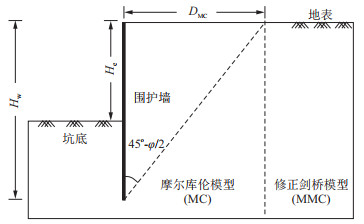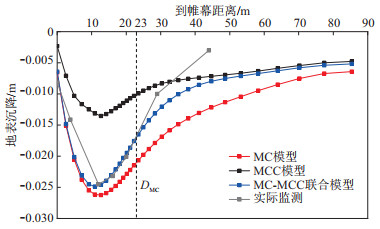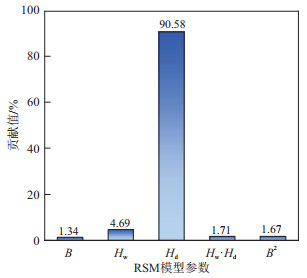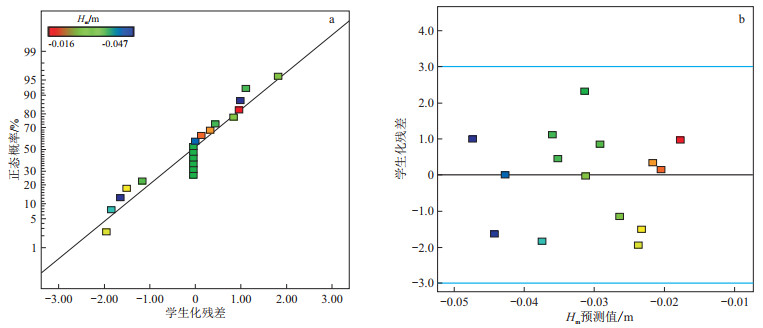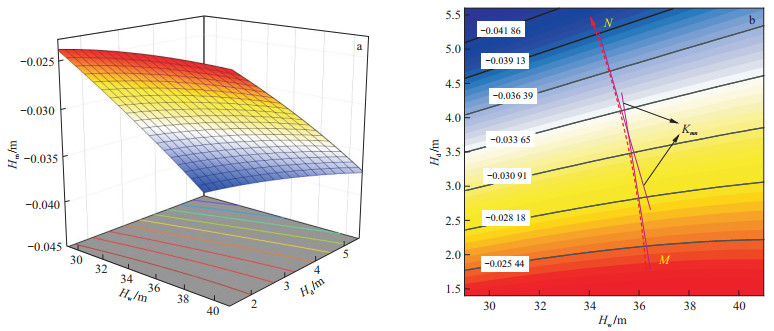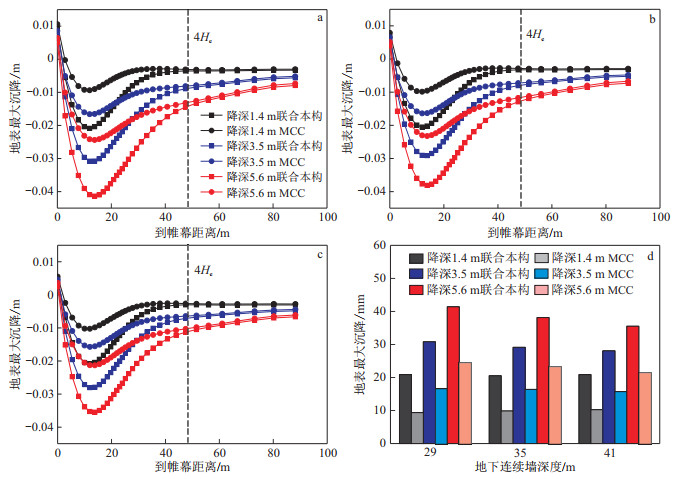Investigations into ground surface settlement characteristics of excavation under dewatering and excavating conditions using the response surface experimental design method
-
摘要:
受降水与开挖作用的共同影响, 基坑周边土体会持续发生地表沉降变形, 对基坑稳定以及周边环境都产生显著影响。为厘清基坑工程降水开挖过程中地表沉降的影响工况因素, 并在此基础上建立经验模型, 选取杭州地区典型江河阶地二元结构地层组合的深基坑为案例, 开展了系统研究。首先, 基于降水开挖作用下的土体变形机理, 结合变形实测数据, 提出了一种结合摩尔库伦(MC)与修正剑桥(MMC)本构关系开展基坑降水开挖沉降过程的数值分析方法。进一步采用响应面试验设计方法(RSM), 考虑多种工况因素及其交互作用, 建立了研究区内二元地质结构条件下基坑降水开挖地表沉降的经验模型, 并分析了地表沉降分区特征。结果表明, 地下水位降深(
H d)对地表沉降影响最为显著, 其次为地下连续墙深度(H w)与开挖宽度(B ), 其中B 与H d交互作用也较为显著。据此建立的回归模型可以较为准确地预测地表最大沉降量。本研究不仅为类似地层条件的基坑工程提供了经验模型, 也为基坑设计、施工和监测提供了实用框架, 对有效控制基坑及周边环境的沉降变形具有重要价值。Abstract:The soil surrounding an excavation experiences continuous ground settlement due to the combined effects of dewatering and excavation, which significantly impacts both the stability of the excavation and its surrounding environment.
Objective To elucidate the key factors governing ground settlement during the dewatering and excavation process, as well as to establish an empirical model based on these findings, this study systematically investigated a deep metro station excavation in Hangzhou, situated on a typical river terrace with a dual-layered geological structure.
Methods Firstly, a numerical analysis method for settlement in braced excavations was proposed by incorporating a hybrid Mohr-Coulomb (MC)-Modified Cambridge (MMC) constitutive model, derived from the deformation mechanism of excavation soil and a comparison with actual monitoring data. Subsequently, the response surface method (RSM) was employed, to establish an empirical model for ground settlement caused by dewatering and excavation under dual-layer geological structure conditions in the study area, accounting for various operational factors and their interactions, and to analyze the zoning characteristics of ground settlement.
Results The findings suggest that the drawdown of the groundwater table,
H d, exerts the most significant influence on the surface settlement, followed by the depth of the underground diaphragm wall,H w, and excavation width,B . Additionally, there is a notable interaction betweenB andH d. The regression model developed based on these factors demonstrates high accuracy in predicting maximum surface settlement,H m.Conclusion This study not only presents an empirical model for excavation engineering under similar geological conditions but also provides a practical framework for excavation design, construction, and monitoring. These contributions are crucial for effectively managing settlement deformation in excavations and their surrounding environments.
-
所有作者声明不存在利益冲突。
-
图 7 RSM模型参数贡献值(代号含义同表 3)
Figure 7. RSM model parameter contribution values
图 11 B×Hd对Hm影响的3D视图(a)和2D视图(b) (符号含义同图 10)
Figure 11. Interaction effect of B×Hd on Hm: 3D view(a); 2D view(b)
图 12 Hw×Hd对Hm影响的3D视图(a)和2D视图(b) (符号含义同图 10)
Figure 12. Interaction effect of Hw×Hd on Hm: 3D view(a); (b) 2D view(b)
图 14 不同连续墙深度下采用MC-MCC联合本构关系与MCC本构关系计算得到沉降曲线随降水深度的变化
a. 连续墙深度29 m; b. 连续墙深度35 m; c. 连续墙深度41 m; d. 地表最大沉降统计
Figure 14. Variation of settlement curves with precipitation depth obtained by using the hybrid MC-MCC constitutive relationship and MCC constitutive relationship under different diaphragm depths
表 1 基坑各土层物理力学参数
Table 1. Physical and mechanical parameters of each soil layer of the excavation
土层 ρ/(kg·m-3) λ κ M ν K/(m·s-1) e E/MPa φ/(°) c/kPa 粉土 1 550 0.035 1 0.003 51 0.857 0.30 1.82×10-6 0.795 20 28 16 淤泥质粉质黏土 1 230 0.179 0 0.015 10 0.880 0.35 1.08×10-8 1.218 40 16 18 粉质黏土 1 600 0.028 3 0.002 83 0.943 0.28 1.00×10-8 0.731 20 24 21 圆砾 1 800 — — — 0.26 5.62×10-5 0.650 150 — — 注:ρ为密度;λ为压缩指数; κ为回弹指数;M为临界压力比;ν为泊松比;K为渗透系数;e为孔隙比; E为弹性模量;φ为内摩擦角;c为黏聚力 表 2 CCD试验设计影响因素水平
Table 2. Factors and levels of CCD experimental design
水平 开挖宽度B/m 连续墙深度Hw/m 水位降深Hd/m -a 13.6 24.9 0.0 -1 17.0 29.0 1.4 0 22.0 35.0 3.5 1 27.0 41.0 5.6 a 30.4 45.1 7.0 注:本文试验设计中a=1.681 79 表 3 基坑降水开挖CCD试验设计与沉降指标响应
Table 3. Working conditions of CCD experimental design and corresponding obtained settlement indices
试验组编号 开挖宽度B/m 连续墙深度Hw/m 水位降深Hd/m 最大沉降量Hm/m 最大沉降点位置Dm/m 1 17.0 29.0 5.6 -0.043 14.583 2 22.0 35.0 3.5 -0.031 13.791 3 22.0 25.0 3.5 -0.035 13.791 4 27.0 29.0 5.6 -0.046 14.165 5 17.0 29.0 1.4 -0.021 12.631 6 17.0 41.0 1.4 -0.020 12.631 7 27.0 41.0 1.4 -0.024 12.413 8 22.0 35.0 7.0 -0.047 13.791 9 22.0 35.0 3.5 -0.031 13.791 10 17.0 41.0 5.6 -0.035 14.583 11 22.0 35.0 0.0 -0.017 11.959 12 22.0 35.0 3.5 -0.031 13.791 13 13.6 35.0 3.5 -0.027 12.698 14 27.0 41.0 5.6 -0.039 12.413 15 22.0 35.0 3.5 -0.031 13.791 16 27.0 29.0 1.4 -0.025 12.413 17 22.0 45.0 3.5 -0.028 11.959 18 22.0 35.0 3.5 -0.031 13.791 19 30.4 35.0 3.5 -0.027 14.298 20 22.0 35.0 3.5 -0.031 13.791 表 4 Hm响应面回归模型方差分析
Table 4. ANOVA of Hm response surface regression model
方差来源 平方和 自由度 均方 F值 P值 显著性 模型 1.181×10-3 9 1.312×10-4 72.49 < 0.000 1 显著 B 1.574×10-5 1 1.574×10-5 8.70 0.014 6 显著 Hw 5.512×10-5 1 5.512×10-5 30.46 0.000 3 显著 Hd 1.064×10-3 1 1.064×10-3 587.79 < 0.000 1 显著 B-Hw 2.656×10-7 1 2.656×10-7 0.15 0.709 7 不显著 B-Hd 1.574×10-7 1 1.574×10-7 0.087 0.774 1 不显著 Hw-Hd 2.009×10-5 1 2.009×10-5 11.10 0.007 6 显著 B2 1.656×10-5 1 1.656×10-5 9.15 0.012 8 显著 Hw2 3.317×10-6 1 3.317×10-6 1.83 0.205 6 不显著 Hd2 3.148×10-6 1 3.148×10-6 1.74 0.216 6 不显著 残差 1.810×10-5 10 1.810×10-6 失拟项 1.810×10-5 5 3.620×10-6 纯误差 0.000 5 0.000 总和 1.199×10-3 19 拟合系数R2 0.984 9 预测R2 0.885 4 调整R2 0.971 3 标准差 0.001 3 表 5 Dm响应面回归模型方差分析
Table 5. ANOVA of Dm response surface regression model
方差来源 平方和 自由度 均方 F值 P值 显著性 模型 62.34 9 6.93 2.48 0.087 1 不显著 B 21.58 1 21.58 7.71 0.019 5 显著 Hw 1.71 1 1.71 0.61 0.452 5 不显著 Hd 5.59 1 5.59 2.00 0.187 9 不显著 B-Hw 0.38 1 0.38 0.14 0.718 9 不显著 B-Hd 0.58 1 0.58 0.21 0.658 8 不显著 Hw-Hd 0.38 1 0.38 0.14 0.718 9 不显著 B2 30.65 1 30.65 10.96 0.007 9 显著 Hw2 0.11 1 0.11 0.041 0.843 8 不显著 Hd2 0.11 1 0.11 0.041 0.843 8 不显著 残差 27.98 10 2.80 失拟项 27.98 5 5.60 纯误差 0.00 5 0.00 总和 90.32 19 拟合系数R2 0.650 7 预测R2 -1.504 9 调整R2 0.336 3 标准差 1.78 表 6 调整后Hm响应面模型方差分析
Table 6. ANOVA of adjusted Hm response surface regression model
方差来源 平方和 自由度 均方 F值 P值 显著性 模型 1.174×10-3 5 2.349×10-4 134.76 < 0.000 1 显著 B 1.574×10-5 1 1.574×10-5 9.03 0.009 5 显著 Hw 5.512×10-5 1 5.512×10-5 31.63 < 0.000 1 显著 Hd 1.064×10-3 1 1.064×10-3 610.32 < 0.000 1 显著 Hw-Hd 2.009×10-5 1 2.009×10-5 11.53 0.004 4 显著 B2 1.966×10-5 1 1.966×10-5 11.28 0.004 7 显著 残差 2.440×10-5 14 1.743×10-5 失拟项 2.440×10-5 9 2.711×10-6 纯误差 0.000 5 0.000 总和 1.199×10-3 19 拟合系数R2 0.979 6 预测R2 0.925 1 调整R2 0.972 4 标准差 0.001 3 表 7 基坑地表沉降影响性分区
Table 7. Influence zones of excavation surface settlement
基坑工程影响区 范围 主要影响区(Ⅰ) 基坑周边0.7He或He·tan(45°-φ/2)范围 次要影响区(Ⅱ) 基坑周边0.7He~(2.0~3.0)He或He·tan(45°-φ/2)~(2.0~3.0)He范围 可能影响区(Ⅲ) 基坑周边(2.0~3.0)He外 注:He为基坑设计深度, m;φ为岩土体内摩擦角, (°);基坑开挖范围内存在基岩时,He可为覆盖土层和基岩强风化层厚度之和;工程影响分区的划分界线取表中0.7He或He·tan(45°-φ/2)的较大值 -
[1] 范士凯, 杨育文. 长江一级阶地基坑地下水控制方法和实践[J]. 岩土工程学报, 2010, 32(增刊1): 63-68.FAN S K, YANG Y W. Groundwater control and practice of deep foundation pits in 1st terrace along Yangtze River[J]. Chinese Journal of Geotechnical Engineering, 2010, 32(S1): 63-68. (in Chinese with English abstract) [2] 郑刚, 杜一鸣, 刁钰, 等. 基坑开挖引起邻近既有隧道变形的影响区研究[J]. 岩土工程学报, 2016, 38(4): 599-612.ZHENG G, DU Y M, DIAO Y, et al. Influenced zones for deformation of existing tunnels adjacent to excavations[J]. Chinese Journal of Geotechnical Engineering, 2016, 38(4): 599-612. (in Chinese with English abstract) [3] 郑刚. 软土地区基坑工程变形控制方法及工程应用[J]. 岩土工程学报, 2022, 44(1): 1-36.ZHENG G. Method and application of deformation control of excavations in soft ground[J]. Chinese Journal of Geotechnical Engineering, 2022, 44(1): 1-36. (in Chinese with English abstract) [4] 骆祖江, 刘金宝, 李朗. 第四纪松散沉积层地下水疏降与地面沉降三维全耦合数值模拟[J]. 岩土工程学报, 2008, 30(2): 193-198.LUO Z J, LIU J B, LI L. Three-dimensional full coupling numerical simulation of groundwater dewatering and land-subsidence in Quaternary loose sediments[J]. Chinese Journal of Geotechnical Engineering, 2008, 30(2): 193-198. (in Chinese with English abstract) [5] 高盟, 高广运, 冯世进, 等. 基坑开挖引起紧贴运营地铁车站的变形控制研究[J]. 岩土工程学报, 2008, 30(6): 818-823.GAO M, GAO G Y, FENG S J, et al. Control of deformation of operating subway station induced by adjacent deep excavation[J]. Chinese Journal of Geotechnical Engineering, 2008, 30(6): 818-823. (in Chinese with English abstract) [6] XU Y S, SHEN S L, MA L, et al. Evaluation of the blocking effect of retaining walls on groundwater seepage in aquifers with different insertion depths[J]. Engineering Geology, 2014, 183(8): 254-264. [7] ZHOU N Q, VERMEER P A, LOU R X, et al. Numerical simulation of deep foundation pit dewatering and optimization of controlling land subsidence[J]. Engineering Geology, 2010, 114(5): 251-260. [8] ZHANG Y Q, WANG J H, CHEN J J, et al. Numerical study on the responses of groundwater and strata to pumping and recharge in a deep confined aquifer[J]. Journal of Hydrology, 2017, 548: 342-352. doi: 10.1016/j.jhydrol.2017.03.018 [9] LUO Z J, ZHANG Y Y, WU Y X. Finite element numerical simulation of three-dimensional seepage control for deep foundation pit dewatering[J]. Journal of Hydrodynamics(Ser B), 2008, 20(5): 596-602. doi: 10.1016/S1001-6058(08)60100-6 [10] PECK R B. Deep Excavations and tunneling in soft ground[C]//Anon. Geology, Engineering. [S. l.]: [s. n.], 1969. [11] BOWLES J E. Foundation analysis and design[M]. 4th ed. New York: McGraw-Hill, 1988. [12] CLOUGH G W, O'ROURKE T D. Construction induced movements of in situ wall[J]. Geotechnical Special Publication, 1990(25): 439-470. [13] HSIEH P G, OU C Y. Shape of ground surface settlement profiles caused by excavation[J]. Canadian Geotechnical Journal, 1998, 35(6): 1004-1017. doi: 10.1139/t98-056 [14] OU C Y, HSIEH P G, CHIOU D C. Characteristics of ground surface settlement during excavation[J]. Canadian Geotechnical Journal, 1993, 30(5): 758-767. doi: 10.1139/t93-068 [15] KUNG G T, JUANG C H, HSIAO E C, et al. Simplified model for wall deflection and ground-surface settlement caused by braced excavation in clays[J]. Journal of Geotechnical and Geoenvironmental Engineering, 2007, 133(6): 731-747. doi: 10.1061/(ASCE)1090-0241(2007)133:6(731) [16] 聂宗泉, 张尚根, 孟少平. 软土深基坑开挖地表沉降评估方法研究[J]. 岩土工程学报, 2008, 30(8): 1218-1223.NIE Z Q, ZHANG S G, MENG S P. Surface settlement of deep foundation pits by excavation[J]. Chinese Journal of Geotechnical Engineering, 2008, 30(8): 1218-1223. (in Chinese with English abstract) [17] 李方明, 陈国兴, 刘雪珠. 悬挂式帷幕地铁深基坑变形特性研究[J]. 岩土工程学报, 2018, 40(12): 2182-2190.LI F M, CHEN G X, LIU X Z. Deformation characteristics of suspended curtain deep foundation pit of metro lines[J]. Chinese Journal of Geotechnical Engineering, 2018, 40(12): 2182-2190. (in Chinese with English abstract) [18] 中华人民共和国住房和城乡建设部. 城市轨道交通结构安全保护技术规范[M]. 北京: 中国建筑工业版社, 2014.Ministry of Housing and Urban-Rural Development of the People's Republic of China. Technical code for protection structures of urban rail transit[M]. Beijing: China Architecture Publishing & Medial Co., Ltd., 2014(in Chinese) [19] 中华人民共和国住房和城乡建设部. 城市轨道交通工程监测技术规范[M]. 北京: 中国建筑工业出版社, 2014.Ministry of Housing and Urban-Rural Development of the People's Republic of China. Code for monitoring measurement of urban rail transit engineering[M]. Beijing: China Architecture Publishing & Medial Co. Ltd., 2014. (in Chinese) [20] 张抒, 唐辉明, 龚文平, 等. 基于物理力学机制的滑坡数值预报模式: 综述、挑战与机遇[J]. 地质科技通报, 2022, 41(6): 14-27. doi: 10.19509/j.cnki.dzkq.2022.0252ZHANG S, TANG H M, GONG W P, et al. Landslide numerical forecasting mode based on physical-mechanical mechanism: Overviews, challenges and opportunities[J]. Bulletin of Geological Science and Technology, 2022, 41(6): 14-27. (in Chinese with English abstract) doi: 10.19509/j.cnki.dzkq.2022.0252 [21] 徐中华, 王卫东. 敏感环境下基坑数值分析中土体本构模型的选择[J]. 岩土力学, 2010, 31(1): 258-264.XU Z H, WANG W D. Selection of soil constitutive models for numerical analysis of deep excavations in close proximity to sensitive properties[J]. Rock and Soil Mechanics, 2010, 31(1): 258-264. (in Chinese with English abstract) [22] SCHANZ T, VERMEER P A, BONNIER P G. The hardening soil model: Formulation and verification[C]//Anon. 1st International PLAXIS Symposium on Beyond 2000 in Computational Geotechnics. Netherlands: A A Balkema Publishers, 2019: 281-296. [23] BRINKGREVE R B J. Selection of soil models and parameters for geotechnical engineering application[C]//Anon. Soil Constitutive Models. Austin, Texas, USA. Reston, VA: American Society of Civil Engineers, 2005: 69-98. [24] 李连祥, 刘嘉典, 李克金, 等. 济南典型地层HSS参数选取及适用性研究[J]. 岩土力学, 2019, 40(10): 4021-4029.LI L X, LIU J D, LI K J, et al. Study of parameters selection and applicability of HSS model in typical stratum of Jinan[J]. Rock and Soil Mechanics, 2019, 40(10): 4021-4029. (in Chinese with English abstract) [25] ZHENG G, ZENG C F, DIAO Y, et al. Test and numerical research on wall deflections induced by pre-excavation dewatering[J]. Computers and Geotechnics, 2014, 62: 244-256. [26] 李广信, 张丙印, 于玉贞. 土力学[M]. 第3版. 北京: 清华大学出版社, 2022.LI G X, ZHANG B Y, YU Y Z. Soil mechanics[M]. 3rd ed. Beijing: Tsinghua University Press, 2022. (in Chinese) [27] 潘静杰, 朱春柏, 刘伟, 等. 外基坑宽度对坑中坑条件下被动土压力的影响[J]. 地质科技通报, 2023, 42(1): 62-69. doi: 10.19509/j.cnki.dzkq.2022.0167PAN J J, ZHU C B, LIU W, et al. Influence of external pit width on passive earth pressure under pit-in-pit condition[J]. Bulletin of Geological Science and Technology, 2023, 42(1): 62-69. (in Chinese with English abstract) doi: 10.19509/j.cnki.dzkq.2022.0167 [28] 中华人民共和国住房和城乡建设部. 建筑基坑支护技术规程[M]. 北京: 中国建筑工业出版社, 2012.Ministry of Housing and Urban-Rural Development of the People's Republic of China. Technical specification for retaining and protection of building foundation excavations[M]. Beijing: China Architecture Publishing & Medial Co., Ltd., 2012(in Chinese). [29] CHENG H, CHEN H, JIA H Y, et al. Probabilistic analysis of ground surface settlement of excavation considering spatial variable modified cam-clay model parameters[J]. Applied Sciences, 2022, 12(19): 9411. [30] SAM H. Applied soil mechanics with ABAQUS applications[M]. New York, USA: Wiley, 2007: 198-213. [31] ASADIZADEH M, MASOUMI H, ROSHAN H, et al. Coupling taguchi and response surface methodologies for the efficient characterization of jointed rocks' mechanical properties[J]. Rock Mechanics and Rock Engineering, 2019, 52(11): 4807-4819. [32] BABANOURI N, ASADIZADEH M, HASAN-ALIZADE Z. Modeling shear behavior of rock joints: A focus on interaction of influencing parameters[J]. International Journal of Rock Mechanics and Mining Sciences, 2020, 134: 104449. [33] ZOU H, ZHANG S, ZHAO J Q, et al. Investigating the shear strength of granitic gneiss residual soil based on response surface methodology[J]. Sensors, 2023, 23(9): 4308. [34] JARRAH N, MU'AZU N D, ESSA M H, et al. Response surface modeling and optimization of sludge activated carbon production conditions for phenolic compounds removal from water[J]. Desalination and Water Treatment, 2017, 100: 320-332. [35] NI W K, ZHONG J X, WANG H M. Effect of polypropylene fiber on the unconfined compressive strength of loess with different water content[J]. Journal of Renewable Materials, 2023, 11(4), 1699-1814. [36] 潘静杰, 朱春柏, 刘伟, 等. 外基坑宽度对坑中坑条件下被动土压力的影响[J]. 地质科技通报, 2023, 42(1): 62-69. doi: 10.19509/j.cnki.dzkq.2022.0167PAN J J, ZHU C B, LIU W, et al. Influence of external pit width on passive earth pressure under pit-in-pit condition[J]. Bulletin of Geological Science and Technology, 2023, 42(1): 62-69. (in Chinese with English abstract) doi: 10.19509/j.cnki.dzkq.2022.0167 [37] 何绍衡, 夏唐代, 李连祥, 等. 地下水渗流对悬挂式止水帷幕基坑变形影响[J]. 浙江大学学报(工学版), 2019, 53(4): 713-723.HE S H, XIA T D, LI L X, et al. Influence of groundwater seepage on deformation of foundation pits with suspended impervious curtains[J]. Journal of Zhejiang University(Engineering Science), 2019, 53(4): 713-723. (in Chinese with English abstract) [38] PHAM B T, NGUYEN-THOI T, LY H B, et al. Extreme learning machine based prediction of soil shear strength: A sensitivity analysis using Monte Carlo simulations and feature backward elimination[J]. Sustainability, 2020, 12(6): 2339. [39] VENDA OLIVEIRA PAULO J, ANUNCIAÇÃO GUILHERME R, CORREIA ANTÓNIO A S. Effect of cyclic loading frequency on the behavior of a stabilized sand reinforced with polypropylene and sisal fibers[J]. Journal of Materials in Civil Engineering, 2022, 34(1): 1-9. [40] MYERS R H, MONTGOMERY D C, ANDERSON-COOK C M. Response surface methodology: Process and product optimization using designed experiments[M]. Hoboken, New Jersey: Wiley, 2016. [41] GB 50497-2019: 建筑基坑工程监测技术规范[S]. 北京: 中国计划出版社, 2020.GB 50497-2019: Technical standard for monitoring of building excavation engineering[S]. Beijing: China Planning Press, 2020. (in Chinese) -






 下载:
下载:
